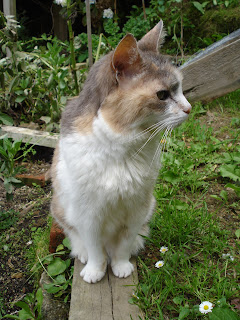 |
| Rose appreciating the Waiheke summer |
Recently Rose, the resident cat, has been plagued by fleas (Ctenocephalides felis). Rose is 18-ish and just recently survived eye surgery (=anaesthetic). She also suffers from advancing dementia. Accordingly, we have a strong desire to see her as comfortable as possible in her last years, above and beyond our personal concerns about being savaged by relentless, prolifically breeding siphonapterans.
 |
| Rose in a colder Wellingtonian clime |
Two flea bombs, fipronil and S-methoprene (courtesy of topical flea treatment) and mild permethrin powder later and we still haven't fully got a handle on the problem. Fipronil blocks the passage of chloride ions in the central nervous system causing hyperexcitation of the insect's nerves and muscles. S-methoprene is an insect growth regulator that works by mimicking the role of juvenile hormones which suppresses the ability of a pupa to moult. Permethrin is a pyrethroid - a human synthesised chemical family similar to the pyrethrums synthesised by Chrysanthemum spp. Permethrin is toxic to cats in doses appropriate for other animals such as dogs, hence label reading and cautious application are mandatory.
The ectoparasitic fucks currently have us at DEFCON 4. They are still coming in from the cold, which means one of Rose's mystery outdoor resting spots is probably riddled with them. When she claims a lap at night we take the opportunity to give her coat the once over, powder at the ready. The regular grooming is extremely satisfying, an enjoyable exercise that becomes somewhat compelling. This is unsurprising when you consider the role of social grooming in animals, especially primates, and that it has been shown to relieve tension and stress. Our flea extermination efforts are apparently being rewarded by beta-endorphin release.
 |
| That which lurks beneath - Ctenocephalides felis magnified 100 times. Steve Gschmeissner /Science Photo Library. |
When clearing honeysuckle (Lonicera japonica) from tall grass earlier this week i began to wonder exactly how this reward is triggered and how spatially and temporally limited the initiating behaviour is. After a fashion i was "grooming" the honeysuckle from the grass/bank/wooded margin - the behaviour seemed to relax me in a familiar way. Part of this seems related to similar levels of concentration at an activity that requires focus, but lacks the frustration or anxiety that can stem from problem solving. There seemed to be some psychological component too - a sense of accomplishment related removing an unwanted element, rendering the area pest free.
However, i imagine that touch, and specific tactile sensations could have a lot to do with triggering grooming rewards. Pulling/digging stringy vines out of sopping wet grass/ muddy soil in damp gloves is a far cry from sitting in a comfortable chair, feeling my fingers brush through Rose's soft, gorgeous smelling hair while her warm body heats my lap!
NB: Most of the info on flea treatments and social grooming was garnered from Wikipedia and verified from other sources. There's a lot out there on the efficacy of fipronil and S-methoprene, if you want to look for it. Not much pan cultural work has been done on social grooming in humans yet.
No comments:
Post a Comment